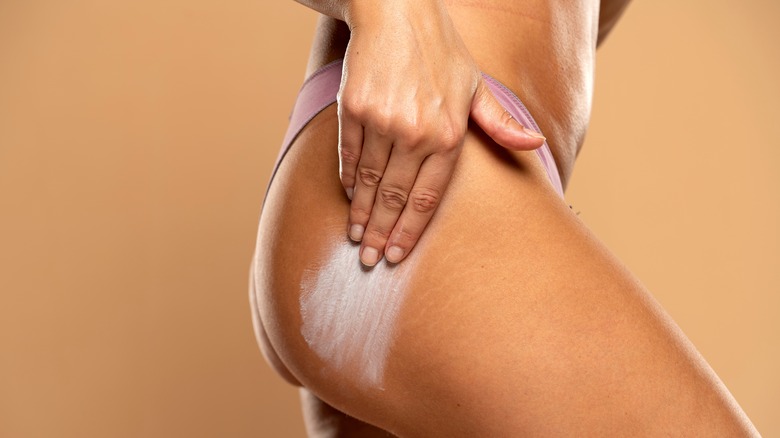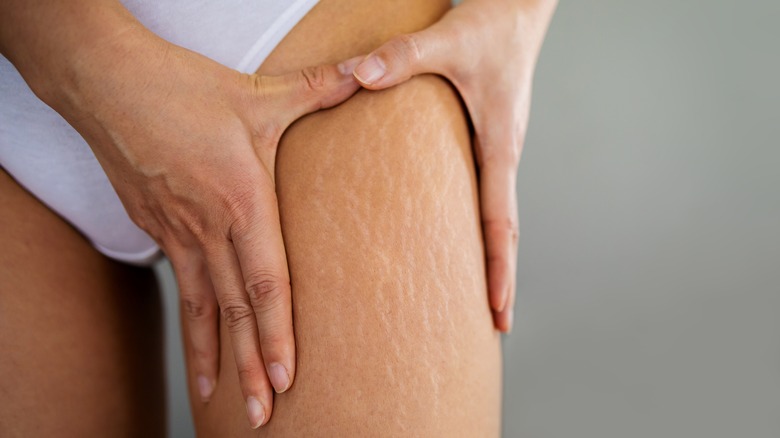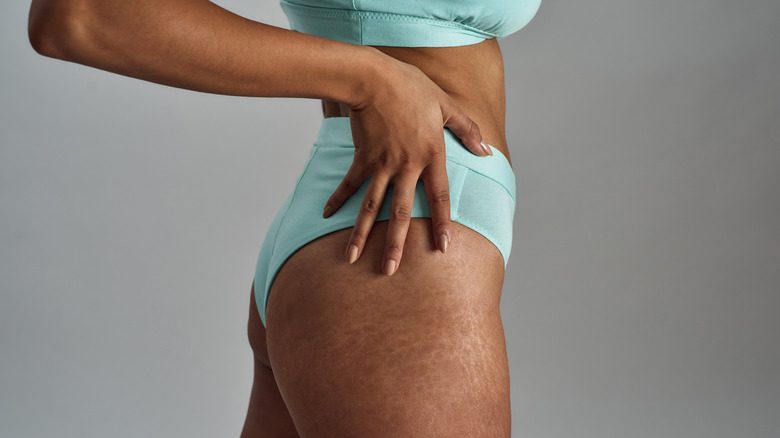Does Retinol Help With Stretch Marks?
The formation of stretch marks, or striae, is a common and natural process that can affect anyone from the age of five to 50 years old, according to Medical News Today. Stretch marks are hardly a cause for concern, though the development of stretch marks can, understandably, lead to feelings of low self-esteem or self-consciousness. Many people, as a result, have turned to home remedies, innovative lasers, hydrating creams, and exfoliative scrubs in an attempt to diminish their stretch marks. Although these indented streaks in the skin cannot be completely removed, they do fade over time, and it is possible to reduce the appearance of stretch marks using treatments such as retinol.
Retinol is a type of retinoid that is derived from vitamin A, and it is typically associated with the removal of wrinkles and various forms of hyperpigmentation, including sun spots, scars, and discoloration (via Healthline). Can this multi-tasking ingredient also help reduce the appearance of stretch marks? Before you head to the nearest pharmacy, here's what you need to know about stretch marks and retinol.
How are stretch marks formed?
You can develop stretch marks in various regions of the body. Most commonly, you will find that stretch marks develop on the hips, buttocks, stomach, and breasts, per the Mayo Clinic. According to Healthline, stretch marks can also form across the lower back, chest, and upper arms. The color and shape of stretch marks may also vary. In the beginning stages, stretch marks can be pink, purple, blue, or brown before they settle and turn white (via the Mayo Clinic). The shape may also vary between thin stripes and thicker streaks.
But what exactly causes stretch marks in the first place? There are several causes for stretch mark formation, some of which are more obvious than others. For instance, puberty is a common cause for stretch marks, as you undergo growth spurts that stretch the skin (via the American Academy of Dermatology). Other common causes include pregnancy, weight gain or loss, and rapid muscle growth. However, you can also develop stretch marks from certain medications, corticosteroids, contraceptives, chemotherapy, and medical conditions such as Cushing's disease or Marfan syndrome, per Medical News Today. So, how can you reduce the appearance of stretch marks?
Can retinol help with stretch marks?
Your genetic predisposition tends to play a factor in stretch mark development. For those who get striae easily, treatments such as creams, lasers, or scrubs have been popular options. Compared to expensive lasers and overpriced creams, however, retinol products are certainly more affordable and accessible.
Retinol works by exfoliating the skin while encouraging cell turnover and collagen production (via Healthline). But does retinol actually help reduce the appearance of stretch marks?
According to a 2016 study in the Journal of the European Academy of Dermatology and Venereology, retinol may improve stretch marks by 20%, which may not seem like much, but demonstrates more success than other options. It's also important to note that retinol is most effective during the early stages of stretch mark formation before they become white in color.
Is retinol a miracle ingredient? Perhaps not. However, retinol does improve the overall appearance of your stretch marks and may encourage them to fade faster by increasing cell turnover. Considering the poor affordability, accessibility, and effectiveness of the other treatment options, it's safe to say that retinol is certainly worth a try if minimizing the appearance of stretch marks is a significant concern.


